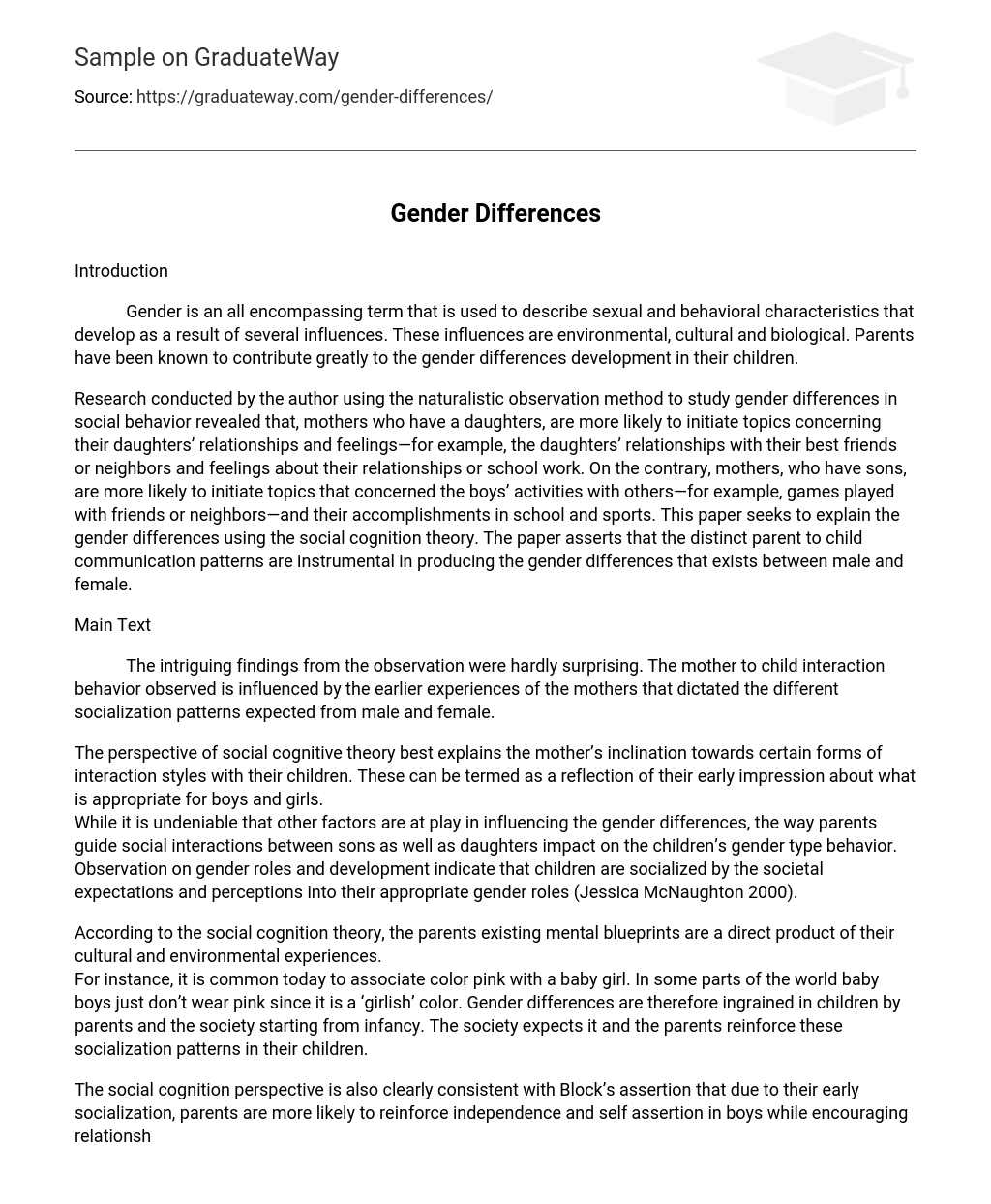Introduction
Gender is an all encompassing term that is used to describe sexual and behavioral characteristics that develop as a result of several influences. These influences are environmental, cultural and biological. Parents have been known to contribute greatly to the gender differences development in their children.
Research conducted by the author using the naturalistic observation method to study gender differences in social behavior revealed that, mothers who have a daughters, are more likely to initiate topics concerning their daughters’ relationships and feelings—for example, the daughters’ relationships with their best friends or neighbors and feelings about their relationships or school work. On the contrary, mothers, who have sons, are more likely to initiate topics that concerned the boys’ activities with others—for example, games played with friends or neighbors—and their accomplishments in school and sports. This paper seeks to explain the gender differences using the social cognition theory. The paper asserts that the distinct parent to child communication patterns are instrumental in producing the gender differences that exists between male and female.
Main Text
The intriguing findings from the observation were hardly surprising. The mother to child interaction behavior observed is influenced by the earlier experiences of the mothers that dictated the different socialization patterns expected from male and female.
The perspective of social cognitive theory best explains the mother’s inclination towards certain forms of interaction styles with their children. These can be termed as a reflection of their early impression about what is appropriate for boys and girls.
While it is undeniable that other factors are at play in influencing the gender differences, the way parents guide social interactions between sons as well as daughters impact on the children’s gender type behavior. Observation on gender roles and development indicate that children are socialized by the societal expectations and perceptions into their appropriate gender roles (Jessica McNaughton 2000).
According to the social cognition theory, the parents existing mental blueprints are a direct product of their cultural and environmental experiences.
For instance, it is common today to associate color pink with a baby girl. In some parts of the world baby boys just don’t wear pink since it is a ‘girlish’ color. Gender differences are therefore ingrained in children by parents and the society starting from infancy. The society expects it and the parents reinforce these socialization patterns in their children.
The social cognition perspective is also clearly consistent with Block’s assertion that due to their early socialization, parents are more likely to reinforce independence and self assertion in boys while encouraging relationship based interactions in their girl children (Block 1983., Dunn, Bretherton & Munn, 1987).
Gender distinct inclinations are evidenced in mother to child interaction patterns where emotional expressions, feelings are emphasized in mother-daughter interactions than in mother to son interaction. There is a strong link between the mother orientation in relation to interaction and mother to child communication.
Predictions on how mother-child interactions affect the child`s development
Mothers display inclinations that emphasize on interpersonal communion, societal values intimacy in relationship, expression of emotions, sharing of confidences and empathy (Jessica McNaughton 2000). Since parents have a major impact on the acquisition of gender type behavior. Mother to child communication may shape the child behavior to nurture and maintain relationship. This is especially important with the girl child.
It is evident from observation that mother to son communication focuses on the boy’s activities as opposed to feelings; this tends to bring out a reliance on power to accomplish goals.
Positives and negatives of mother to child interaction
Mother to child communication is beneficial in developing the child’s ability to build relationship as well as being sensitive to feelings of others.
On the other hand this communication may result in overdependence on others. Mother to boy interaction if not well balanced can make the boy child to have difficulties when relating to other boys who he might consider too rough. The other boys may in turn term him a sissy.
Conclusion
Gender differences develop from as early as infancy period. Boys and girls are socialized to act in the prescribed way. This is largely dependent on the parent’s orientation pertaining to interactions which influences the children’s gender type behavior. Girls are encouraged to build and maintain relationship as well to be more expressive. Boys on the other hand are taught to restrict feelings and to be more independent. All these socialization have a bearing on the way males and females develop.
References
Block, J. H. (1983) Differential premises arising from differential socialization of the sexes:
Some conjectures. Child Development 54: 1335-1354.
Jessica McNaughton (2000). Gender Differences In Parent Child Communication Patterns.
Available at: http://murphylibrary.uwlax.edu/digital/jur/2000/mcnaughton.pdf. Accessed
on 2. 7. 2007





